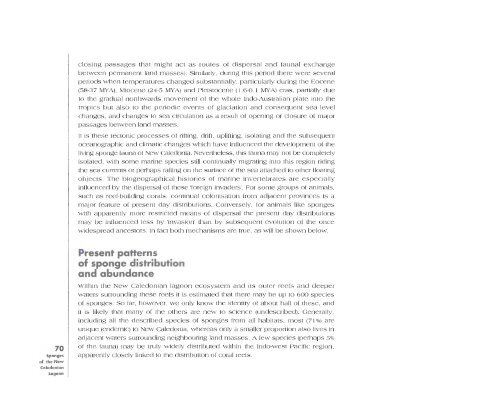Sponges of the New Caledonian lagoon - IRD
Sponges of the New Caledonian lagoon - IRD
Sponges of the New Caledonian lagoon - IRD
You also want an ePaper? Increase the reach of your titles
YUMPU automatically turns print PDFs into web optimized ePapers that Google loves.
70<br />
<strong>Sponges</strong><br />
<strong>of</strong> <strong>the</strong> <strong>New</strong><br />
<strong>Caledonian</strong><br />
Lagoon<br />
closing passages that might act as routes <strong>of</strong> dispersal and faunal exchange<br />
between permanent land masses). Similarly, during this period <strong>the</strong>re were several<br />
periods when temperatures changed substantially, particularly during <strong>the</strong> Eocene<br />
(58-37 MYA), Miocene (24-5 MYA) and Pleistocene (1.6-0.1 MYA) eras, partially due<br />
to <strong>the</strong> gradual northwards movement <strong>of</strong> <strong>the</strong> whole Indo-Australian plate into <strong>the</strong><br />
tropics but also to <strong>the</strong> periodic events <strong>of</strong> glaciation and consequent sea level<br />
changes, and changes to sea circulation as a result <strong>of</strong> opening or closure <strong>of</strong> major<br />
passages between land masses.<br />
It is <strong>the</strong>se tectonic processes <strong>of</strong> rifting, drift, uplifting, isolating and <strong>the</strong> subsequent<br />
oceanographic and climatic changes which have influenced <strong>the</strong> development <strong>of</strong> <strong>the</strong><br />
living sponge fauna <strong>of</strong> <strong>New</strong> Caledonia. Never<strong>the</strong>less, this fauna may not be completely<br />
isolated, with some marine species still continually migrating into thiS region riding<br />
<strong>the</strong> sea currents or perhaps rafting on <strong>the</strong> surface <strong>of</strong> <strong>the</strong> sea attached to o<strong>the</strong>r floating<br />
objects. The biogeographical histories <strong>of</strong> marine invertebrates are especially<br />
influenced by <strong>the</strong> dispersal <strong>of</strong> <strong>the</strong>se 'foreign invaders'. For some groups <strong>of</strong> animals,<br />
such as reef-building corals, continual colonisation from adjacent provinces is a<br />
major feature <strong>of</strong> present day distributions. Conversely, for animals like sponges<br />
with apparently more restricted means <strong>of</strong> dispersal <strong>the</strong> present day distributions<br />
may be influenced less by 'invasion' than by subsequent evolution <strong>of</strong> <strong>the</strong> once<br />
widespread ancestors. In fact both mechanisms are true, as will be shown below.<br />
Present patterns<br />
<strong>of</strong> sponge distribution<br />
and abundance<br />
Within <strong>the</strong> <strong>New</strong> <strong>Caledonian</strong> <strong>lagoon</strong> ecosystem and its outer reefs and deeper<br />
waters surrounding <strong>the</strong>se reefs it is estimated that <strong>the</strong>re may be up to 600 species<br />
<strong>of</strong> sponges. So far, however, we only know <strong>the</strong> identity <strong>of</strong> about half <strong>of</strong> <strong>the</strong>se, and<br />
it is likely that many <strong>of</strong> <strong>the</strong> o<strong>the</strong>rs are new to science (undescribed). Generally,<br />
including all <strong>the</strong> described species <strong>of</strong> sponges from all habitats, most (71 %) are<br />
unique (endemic) to <strong>New</strong> Caledonia, whereas only a smaller proportion also lives in<br />
adjacent waters surrounding neighbouring land masses. A few species (perhaps 5%<br />
<strong>of</strong> <strong>the</strong> fauna) may be truly widely distributed within <strong>the</strong> Indo-west Pacific region,<br />
apparently closely linked to <strong>the</strong> distribution <strong>of</strong> coral reefs.

















